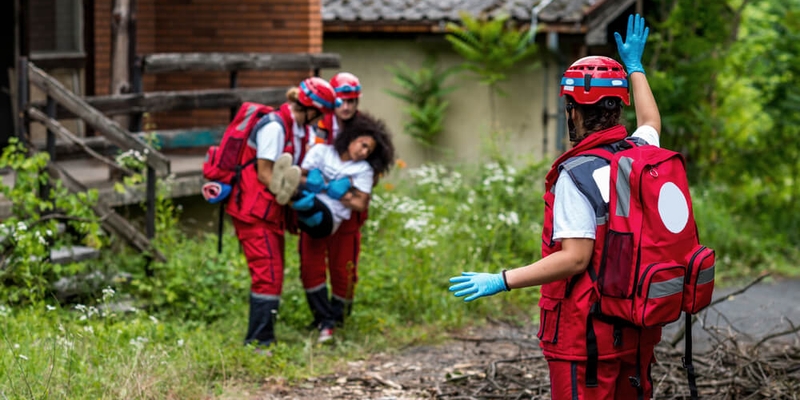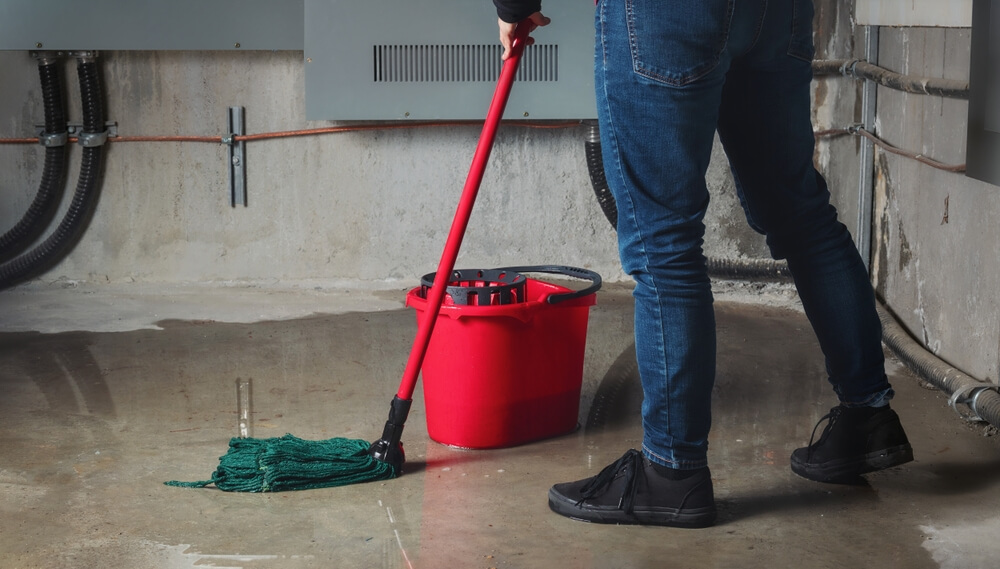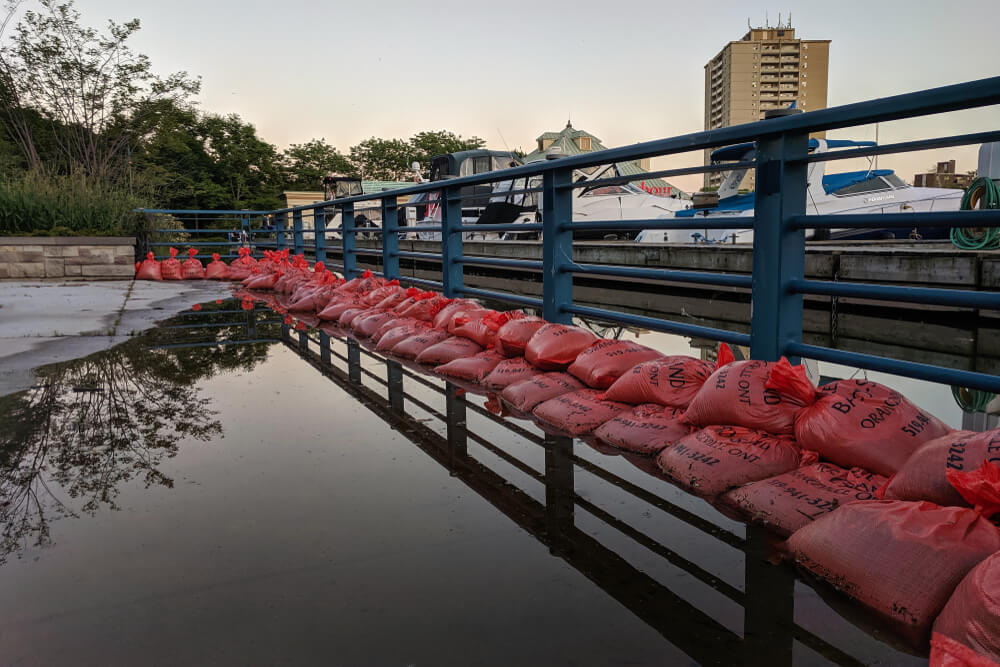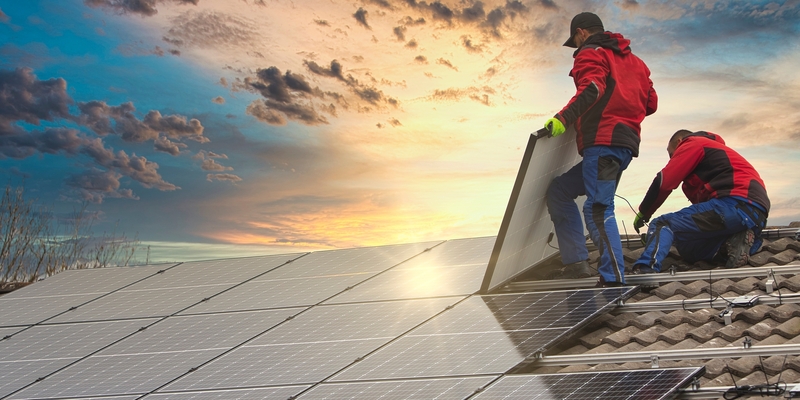Get the Cheapest Overland Water Coverage in Canada
Find overland water home insurance at the cheapest rate available.
Compare overland water home insurance quotes from providers you trust
Jump straight to:
- What is overland water home insurance?
- Do I need overland water home insurance?
- What does overland water home insurance cover?
- What’s not covered by overland water home insurance?
- Overland water vs. water damage vs. sewer back-up… What’s the difference?
- Frequently asked questions about overland water home insurance
What is overland water home insurance?
Overland water (also known as inland flooding) home insurance is optional water damage protection for your home, condo or rental property. Overland water refers to flooding caused by external sources of water like streams, rivers, lakes or ponds, which overflow onto dry land. The coverage also protects your property from excessive rainwater and thawing snow, as they sometimes seep into basements, causing damage.
When people say ‘flood insurance,’ what they likely mean is ‘overland water coverage.’
Beware: Water damage coverage comes in three different flavours
Your home insurance might include something called ‘water damage’ coverage.
That’s NOT the same as overland water. The key distinction is that water damage coverage protects your property from sources located within its boundaries (indoor or outdoor), such as plumbing, fixtures and appliances (a burst pipe or leaky air conditioning would fall under this). If the source of water is external, this coverage won’t apply.
But, it gets even trickier. If your home ends up flooded because of a backed-up sewage system in your area – causing sewage water to enter your home through drains and toilets – neither overland water nor water damage coverage would protect you.
That’s where sewer back-up coverage comes in. Usually, it gets packaged with overland water, but not always, as it is its own add-on. Be mindful of that.
What about tidal flooding?
Most insurance companies in Canada do not cover tidal flooding – which is flooding caused by rising sea water levels (including tides and tsunamis). If you live on a coast, be aware that your water damage protections do not apply to rising sea water.
According to a recent study, more than 3.9 million Canadians live in areas that might be impacted by coastal flooding by the end of the century. If you think your home is at risk, learn more about coast flooding from the Government of Canada.
Do I need overland water home insurance?
Not every homeowner will need overland water home insurance.
When deciding whether you need this coverage or not, ask yourself these questions:
- How close is your home to a lake, river, pond or stream and how likely is it to overflow and cause a flood?
- How likely is rainwater or thawing snow to accumulate on your property to start seeping into your basement?
- Do you have a basement?
It’s true that the risk of flooding has increased over the last decade and will continue to increase. According to the Canadian Climate Institute, extreme rainfall events, which currently occur every 20 years in Canada, could occur every five years by the end of the century. In 2024, flooding cost southern Ontario over $940 million in insured damage, according to the Insurance Bureau of Canada (IBC). Meanwhile, total insured losses from flooding cost the whole country close to $800 million per year over the last decade.
If water were to seep into your basement – whether the basement is finished or not – it can cause a lot of problems. For instance, water in the walls can freeze, thaw and weaken your home’s overall foundation or even cause wood rot.
On the other hand, if you don’t have a basement or you live above ground level (in a high-rise building, for example), overland water coverage would be redundant.
Weigh your risks based on your proximity to major bodies of water like lakes or rivers and the likelihood of rainwater or snow seeping into your basement. If the risk is low or non-existent, you should probably forego this coverage and save yourself some money.
What does overland water home insurance cover?
Overland water home insurance should protect your home against the following water-based dangers:
- Floods caused by overflowing bodies of water like lakes, rivers, streams or ponds.
- Heavy rain and snow accumulation, which can cause water to seep into your home’s foundation through basement windows, garage doors or cracks in basement walls.
- Accidental dam break.
What’s not covered by overland water home insurance?
As is the case with other types of home insurance coverage, the water damage has to be sudden and unexpected. If it’s not, it’s unlikely to get covered.
Overland water coverage will not apply in these scenarios:
- If rainwater or snow gets into your home through an open door or window.
- If your roof leaks due to being too old (over 10 years) and in poor condition.
- If water leakage comes from neglected appliances, fixtures or pipes and has been occurring slowly, over several months or years.
- If you get damage from sewer water caused by a backed-up sewage system in your area.
- If your property is damaged by sea water (due to a tide or tsunami).
Overland water vs. water damage vs. sewer back-up… What’s the difference?
Overland water | Water damage | Sewer back-up | |
|---|---|---|---|
What does it cover? | Water damage caused by bodies of water, like lakes, rivers, streams or ponds, overflowing onto dry land and causing floods.
Water damage caused when excessive rainwater or thawing snow seeps into the home through basement windows, doors or wall cracks. | Water damage caused by a sudden leak from a local fixture, appliance or pipe. | Water damage caused by sewage water that enters the home through drains and toilets as a result of a backed-up sewage system in the area. |
What does it not cover? | Rainwater or snow that enters the home through open windows or doors.
Water damage that occurs slowly due to poor structural maintenance (e.g., roof that hasn’t been repaired in over 10 years). | Water damage caused by any source outside the property.
Water damage that occurs slowly due to neglected appliances, fixtures or plumbing. | Any water damage that isn’t the result of a sewer back-up. |
Is it included in a standard policy? | No. | Yes. | No. |
Recent home insurance quotes

Recent home Insurance Quote from Chatham, ON
Detached 1,510 sq ft
July 11, 2025
Cheapest Quote
$ 160 / month
$ 1,922 / yearAverage Quote
$ 305 / month
$ 3,660 / yearSavings
$ 145 / month
$ 1,740 / year
47 %
Recent home Insurance Quote from Hanmer, ON
Detached 1,272 sq ft
July 11, 2025
Cheapest Quote
$ 82 / month
$ 989 / yearAverage Quote
$ 98 / month
$ 1,177 / yearSavings
$ 16 / month
$ 192 / year
16 %
Recent home Insurance Quote from North york, ON
Detached 3,230 sq ft
July 11, 2025
Cheapest Quote
$ 182 / month
$ 2,181 / yearAverage Quote
$ 290 / month
$ 3,479 / yearSavings
$ 108 / month
$ 1,296 / year
37 %
Home insurance quotes are compared from Apollo Insurance, CAA, Economical Insurance, Pembridge, Square One Insurance, and SGI
How to get overland water home insurance on RATESDOTCA
Ready to compare quotes and save?
Tell us about your home
Answer a few basic questions about your home. It won't take long!
Compare your quotes
See quotes from top insurance companies side by side.
Choose the right coverage
Find the right protection for your home and everything in it.
Secure your rate
Connect with the provider and secure your rate.
What people say about our quotes

Based on 6,448 reviews

Amazing
Very helpful and easy to use
Safe travels

Easy quick selection of rates
Easy quick selection of rates
J K

Great help in finding the best rate!
Great help in finding the best rate! Thanks a lot!
Ruthielyn opina

I like how I can quickly I can select…
I like how I can quickly I can select travel insurance. The web site had an issue earlier but seemed to correct itself.
Dennis

prompt service
Respnded quickly, recommended company was excellent
Michael W.

Save time and money with rates.ca
I always use rates.ca for my travel insurance. They compare rates from several insurance companies and I can choose the package that suits my needs. I save time, frustration, and best of all, money. Thank you rates.ca, I will definitely be using your service again in the future.
customer
Frequently asked questions about overland water home insurance
Got more questions about overland water home insurance? We got you covered.
Is overland water coverage mandatory in Canada?
No. Home insurance is not required by law in Canada. Among those homes that are insured, the government doesn’t require homeowners to add overland water coverage to their insurance policies.
However, many homeowners have home insurance because most lenders require coverage before they’ll offer a mortgage. Depending on the location of the home you’re mortgaging, a lender may require that your home insurance policy also include overland water protection.
Is overland water coverage the same as flood coverage?
Overland water coverage and flood coverage are often used interchangeably.
However, overland water is not the only coverage to protect your home from a flood and should not be confused with ‘water damage.’ The latter is standard coverage that’s included in most, if not all, home insurance policies. It protects your home from sudden or unexpected leaks produced by a fixture, appliance or plumbing within the bounds of your property.
Overland water damage, on the other hand, is usually purchased as an add-on – meaning it’s not included in most standard home insurance policies. The coverage protects your home from damage caused by fresh water that flows above ground. Examples include:
- The overflow of any body of fresh water, such as a lake, pond, stream or river.
- Heavy precipitation, such as rain or melting snow or ice.
It's worth pointing out that for your overland water claim to be accepted, the water must have entered your home through the windows, doors or wall cracks at the foundational level. Overland water will not cover damage caused by seepage through the roof or upper windows. It also won’t come into effect if the water gets into your home through an open door or window.
Tidal or coastal flooding – which is caused by abnormally high sea water levels – is also not covered by overland water. In fact, there is no tidal flooding coverage in Canada.
Water damage caused by sewage water that enters your home through toilets or drains due to a backed-up sewage system in your area does not fall under overland water either. For that you’d need to purchase a separate add-on, known as ‘sewer back-up.’
If I live in a high-rise building, do I still need overland water coverage?
We recommend that you consider purchasing overland water and sewer back-up protection, regardless of whether you live in a home or a condominium or high-rise building.
Your home insurance policy is likely to protect against water damage, such as that from a burst pipe, but, will not include protection against flooding. For that you will need to add flood protection to your policy.
While condo buildings have their own insurance policies, it is unlikely to cover damage to your individual unit. Shared common spaces will be covered, but damage to your home and its contents will only be covered by your own policy.
An additional benefit of condo dwellers having overland and sewer back-up coverages is that they serve as protection for any damage to the contents of underground storage lockers such they be damaged by a flood.
How much does overland water home insurance coverage cost?
Overland water coverage could cost you $15 to $35 per month – or $180 to $420 per year – depending on how much of a risk overland flooding poses to your area. If you live in a low-risk area, your overland water coverage could be free – though the likelihood of that is low.
How do I file an overland water home insurance claim?
When it comes to insurance claims, it’s best to file them as soon as you can. However, given that overland floods may require you to leave your home – either due to an evacuation order or your own choice – filing a claim right away may not be feasible.
That said, you should still strive to file a claim sooner rather than later. Here are the steps:
Step 1: Take stock of all your damaged or lost items
Make a detailed list of everything that got damaged, destroyed or lost, including parts of the property itself (e.g., walls, doors and fixtures) as well as personal possessions such as furniture, electronics and clothing.
Take photos of the damaged items and try to find photos of the items that got lost. If you can attach proof of purchase, receipt, warranty or a similar piece of documentation to every lost or damaged item, do so.
Also, do not discard any of the damaged or destroyed items unless they pose a risk to your health.
In general, it’s always a good idea to have a detailed inventory of all your items ahead of time, so if you have a moment, consider putting one together as soon as possible.
Step 2: Get in touch with your insurance provider
With a list of all your damaged, destroyed or lost items in hand, go ahead and report the incident to your insurance provider. Most companies have 24-hour claims services, so you can do this at any time (our recommendation is to report all insurance-related incidents as soon as you can).
Be sure to convey as much information about your situation as possible, including the extent of the damage to your property.
If the damage is so extensive that you can’t even live on your property, be sure to ask about the Additional Living Expenses (ALE) coverage, which would provide you with funding for temporary accommodations, including costs like your hotel room, groceries and extended travel.
For ALE to apply, keep all your receipts, so you can get those costs reimbursed.
Once your claim is filed, the insurance company will assign a claims adjuster to your case, who will conduct a detailed investigation of what happened and determine the appropriate coverage amount.
Step 3: Complete a proof of loss form
Your insurer will ask you to sign a proof of loss form, which would list all your damaged, destroyed or lost property alongside the cost of their replacement or repairs. Make sure the document reflects the reality of what has occurred. Otherwise, your insurance claim could become void.
Is overland water coverage included in my current home insurance policy?
If you have a standard home insurance policy, then it probably does not include overland water coverage. ‘Overland water’ refers to damage caused by bodies of water like lakes, rivers, streams or ponds when they overflow onto dry land, resulting in flooding. The coverage also protects homes from damage due to excessive rainwater or thawing snow, which sometimes seeps through basement windows, doors or wall cracks.
If you want this coverage, you’ll need to purchase it separately, as an add-on.
Note that your policy probably includes coverage called ‘water damage.’ This is not the same as ‘overland water.’ Water damage refers to sudden damage caused by faulty plumbing, appliances or fixtures that are located on your property (e.g., your dishwasher).
Does overland water home insurance have a deductible?
Yes, overland water coverage can have its own deductible that is separate from your overall home insurance deductible. In fact, deductibles for overland water can be as high as $20,000. For contrast, regular home insurance deductibles are around $1,000.
This varies by insurer, however. In some cases, your overland flooding coverage may share a deductible with the rest of your policy.
Carefully review your insurance agreement, and if you’re still confused, contact your insurance representative so they can explain how your deductibles work.
Do note that the higher the deductible, the more you have to pay out of pocket. In some cases, a deductible may be so high that you may receive zero coverage. For example, if your overland water deductible is $20,000 and the cost of damage is $10,000, then your claim would be rejected – since you’d be expected to cover any damage costs (related to overland flooding, specifically) up to the amount of $20,000. If in this same scenario, your damage cost is $22,000, then your insurer would cover $2,000, leaving the rest to you.
Why wouldn’t my insurance provider offer me overland water coverage?
If you live in an area where overland floods are frequent and cause extensive property damage, your insurer may not offer you overland water coverage due to the risk being too high.
If that’s the case, you may want to explore various disaster assistance programs offered by the Government of Canada, including the Disaster Recovery Assistance for Ontarians (DROA).
Is water overland water coverage an add-on?
Yes, overland water coverage is an add-on, which means that most home insurance policies do not include it by default. If you’ve purchased home insurance without looking too deeply into your water damage coverage options, it’s likely that overland water is excluded from your policy.
To confirm what you have or don’t have, be sure to chat with your insurance provider – they’ll explain everything.










